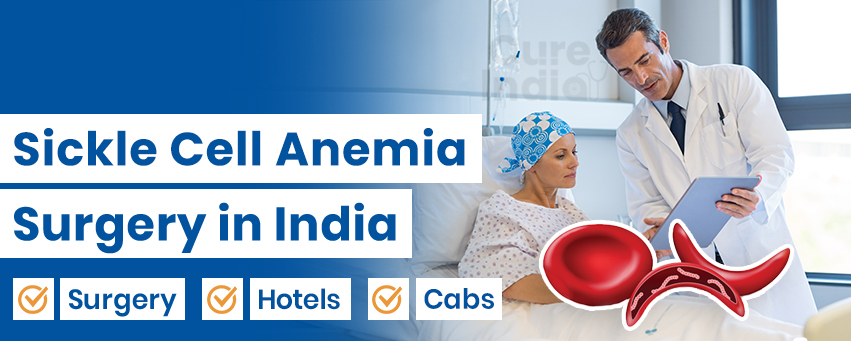

India has emerged as one of the leading destinations for various complex transplant treatments. Especially for African patients, the country is becoming a global healthcare industry, particularly renowned for its expertise in sickle cell anemia treatment. It's no wonder why patients from different african countries fly overseas every year. While sickle cell anaemia treatment is quite expensive in their home country, Africans find India a much more cost-effective solution.

Moreover, India is the host to advanced hospitals for sickle cell anemia treatment that ensure the highest quality standards. Beyond treatment itself, Indian healthcare offers hope and healing to countless patients from around the world, including Africa. Thus, patients from Congo, Ethiopia, Kenya, Uganda, Ghana, and others consider India one of their reliable destinations.
Sickle cell anemia genetics is a genetic blood disorder in which your red blood cells become stiff and crescent-shaped. Usually, these cells are round and flexible, but they get misshapen due to sickle cell anaemia and cannot flow smoothly through blood vessels.

This sickle cell anaemia genetics condition leads to blockage in the cells that prevent oxygen from reaching your vital organs. This condition can also lead to some severe complications, such as stroke, organ damage, and chances of infection. Therefore, people with sickle cell anemia experience intense pain and call it a sickle cell crisis.
Although there is no absolute sickle cell anemia treatment, sickle cell disease treatments like blood transfusion, bone marrow transplant, medications, and lifestyle changes can help you manage these symptoms for a long time. Bone marrow transplants are showing promising results for the future. They're particularly effective for patients who have gone through by India's best sickle cell anemia surgeons. Moreover, if you get an early diagnosis and regular medical care, you can significantly improve your quality of life for living with sickle cell anaemia.
Sickle cell anaemia is a global disease, and almost 8 million people suffer from it worldwide. The disease is especially significant with its risk in 9 out of every 10 Africans or those with African ancestry. According to the World Health Organisation (African region), in African countries like Ghana, Nigeria, and the Congo, almost 20% to 30% of people suffer from sickle cell anemia. Meanwhile, nearly 45% of Africans suffer from this condition in some parts of Uganda.
For every 12 black babies born, about one will have this disease, meaning they inherited the sickle cell anemia genetics from their parents. This high prevalence is primarily due to genetic mutation.
Moreover, Africa has inferior medical infrastructure; thus, without proper medical treatment, many children with sickle cell anaemia die before the age of five. The growing numbers necessitate increased efforts to raise awareness about health issues, implement early diagnosis, and provide effective sickle cell anaemia treatment.
Several types of sickle cell disease can occur among patients who have inherited genes from their parents. The following are:
This is one of the most common and severe types of sickle cell disease anemia, affecting almost 65% of people who have SCD. Patients inherit two copies of defective genes from both parents. The abnormal haemoglobin in Hbss causes the red blood cell to become misshapen and sickle-shaped.
It is similar to sickle cell anaemia or HbSC but less severe. This is also a genetic blood disorder in which patients inherit one S gene from one parent while they get the other sickle cell gene or one C gene from another parent. While HbSc is less severe than HBSS, it can still cause significant health issues.
In this sickle cell condition, patients inherit one sickle gene and another gene of beta-thalassemia. It is a combination of sickle cell disease and beta-thalassaemia. Thus, HbS is a more severe cell condition that is at higher risk than HbSC. The sickle cell gene causes red blood cells to become misshapen, while the beta-thalassemia genes reduce the production of haemoglobin.
- Beta-zero Thalassaemia: This is a more severe form of sickle cell disease that affects 2% of people with SCD. It results in almost no production of beta-globin, a crucial element of haemoglobin.
- Beta-Plus Thalassaemia: Beta-plus affects almost 8% of people with SCD. It tends to be milder since some normal haemoglobin is produced.
Sickle cell disease symptons usually appear around 6 months of age, and sickle cell disease symptoms can vary from person to person. These symptoms include:

These symptoms can turn into severe complications if you do not take proper medical intervention or pain management. Visit your healthcare provider right away if the symptoms start more often. The life-threatening complications can be:
Dr. Archit Pandit is one of the leading Surgical Oncologists of the country. His focussed areas of expertise include, GI, Gynaecological & Breast Cancer, Laparoscopic Cancer Surgeries, Gastro-Esophageal Cancer, Robotic Cancer Surgeries, Urological cancers and Head & Neck Cancer, to mention a few.

Dr. Harish Verma is a highly distinguished surgical oncologist in India who brings over 14 years of specialised experience to his practice. He is renowned for his expertise in performing intricate surgeries for a range of cancers, including breast cancer, esophagal cancer, lung cancer, and gastrointestinal cancer.

Dr. Lalit Kumar is the top bone marrow surgeon in Delhi with 25 years of experience in the field of hemato-oncology and BMT. At present, he is the chairperson and oncologist hematologist in Artemis Hospital, Gurgaon, and New Delhi. He offers years of experience and intense knowledge in both his national and international career illustration.

Dr. Vinay Samuel Gaikwad is a dynamic and extensively trained cancer surgeon. He has a rich clinical experience of more than two decades and has previously been associated with some of the top hospitals in India. He completed his Fellowship in GI & HPB Surgical Oncology from Tata Memorial Hospital, Mumbai

The cost of sickle cell anaemia treatment significantly varies across different regions worldwide. In the case of competitive pricing, India is one of the famous names among many medical tourists from various countries. African patients especially consider India as one of the most affordable countries with high-quality treatment.
For instance, in many African countries, the sickle cell disease treatments are quite affordable, though the quality of healthcare and infrastructure is inferior and limited. At the same time, Africans can avail of advanced treatments like bone marrow transplants with an annual expense ranging between $2,000 and $8,000 in India.
India has a robust medical infrastructure, with world-class facilities and affordable care, making it a leading destination. Therefore, it is no wonder why patients choose India over the UK and USA for sickle cell anemia treatment at a fraction of the cost.
| Treatment | Cost in India | Stay in India |
|---|---|---|
| Sickle Cell Anemia Treatment in India | $22,000 - $35,000 | 2 Months |
Several sickle cell anemia treatments are available in India for sickle cell testing and management. Indian skilled and highly trained doctors aim to reduce pain and prevent complications with the latest methods of treatment. Here are some main types of sickle cell anaemia treatments in the following:

This is the most effective sickle cell disease treatments currently known for sickle cell anaemia. In this procedure, doctors replace your unhealthy bone marrow, which produces defective-shaped red blood cells, with a healthy one from a donor.
This procedure is often called a stem cell transplant. However, only the patient's genetic matches (Brother and Sister) are suitable for this bone marrow transplant. Thus, finding a suitable donor is challenging for those who have no other siblings.
Blood transfusions on a regular basis can help raise the number of healthy red blood cells in your body. It also reduces the risk of stroke and other severe complications related to sickle cell anaemia. In this procedure, patients receive blood from a healthy donor, which replaces the unhealthy and misshapen red blood cells.
As a result, it increases the number of healthy blood cells and helps prevent painful blood vessel blockages. Moreover, regular transmission will help prevent organ failures and protect organs like the liver, kidney, and spleen from sickle cell disease.
Another rapidly evolving sickle cell disease medication is gene therapy. With this innovative approach, doctors modify your genetic material of cells to treat the disease. The sickle cell anaemia genetic mutation is the underlying reason that affects the hemoglobin protein in red blood cells.
This therapy aims to correct this mutation by inserting a healthy version of the gene into the patient's blood cells. Gene therapy provides a long-lasting or even life-long result by correcting a patient's genetic defect. Moreover, it can significantly improve the quality of life for patients by eliminating painful crises.
Some sickle cell disease medications can also help in preventing sickle cell anaemia by promoting foetal haemoglobin productivity. For example, hydroxyurea prevents red blood cells from getting sickle-shaped. While over-the-counter and prescription painkillers can also help you manage intense pain.
Sickle cell anaemia patients are more prone to stroke, infection, and other complications. Thus, some antibiotics or vaccinations can help prevent illnesses like pneumonia.

Successful Liver Transplant Surgery in India
Share Your Reports
Minimally invasive Liver donor surgery
Book appointment